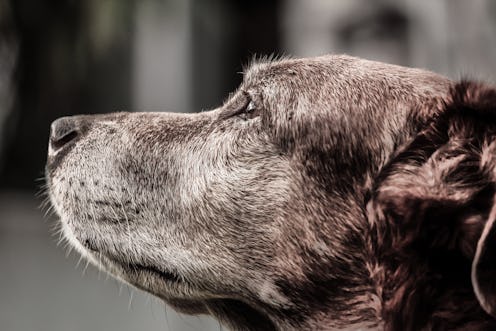Life
Why Some Dogs Go Prematurely Gray
Although the sight of a gray hair might send humans spiraling into a series of poor decisions culminating in the purchase of a sports car they don't need, most people think nothing of premature gray hair in dogs. After all, it just makes their widdle faces look distinguished. Unfortunately, a recent study found that the reason why some dogs go gray at an early age might be the same one as humans: They're worrywarts. Please take this time to grab the nearest puppy and cuddle them until all their worries disappear.
In a study published in Applied Animal Behavior Science, a journal for the International Society for Applied Ethology, researchers rated the muzzle grayness of 400 dogs in photos taken at dog parks, veterinary clinics, and other locations across Colorado. (Fun fact: The team included famed animal researcher Temple Grandin.) These dogs' owners were asked to fill out a questionnaire measuring their pet's behavior and characteristics — including their levels of anxiety and impulsivity. By the way, anxious dog behaviors include cowering in large groups of people and destruction of their surroundings when left alone; impulsivity manifests in things like jumping all over the only cat person in the room. Well, technically, impulsive dogs will jump on anyone, but in my experience they always manage to find the person who's already terrified of dogs.
In the end, researchers found that characteristics like dog size and even medical problems didn't predict muzzle grayness, but it was linked to anxiety and impulsivity. Interestingly enough, female dogs showed more grayness than male dogs on average. As usual, there's no way to tell if dogs went prematurely gray because they're more anxious, but researchers concluded that it "may be a possible indicator of anxiety, fear or impulsivity issues in dogs under four years of age."
In a statement, study author Camille Smith said, "Based on my years of experience observing and working with dogs, I’ve long had a suspicion that dogs with higher levels of anxiety and impulsiveness also show increased muzzle grayness."
It might seem like a uniquely human problem upon first consideration, but anxiety in dogs is more widespread than you might think. Separation anxiety is one of the most common behavioral problems in dogs and cats; according to the American Veterinary Medicine Association, it's diagnosed in 20 to 40 percent dogs referred to animal behavior practices in North America. According to a market research report cited in The Atlantic, Americans spent around $7.6 billion on medication for their pets in 2013, and that includes psychiatric medications for problems like anxiety.
So if you've ever felt like your dog has weirdly human-like characteristics, you might be on to something. It would be nice if anxiety wasn't an issue at all, but at least you and your dog understand what the other is going through during tough times. That's what best friends are for — even the canine ones.
